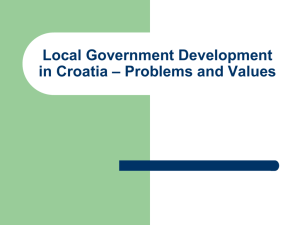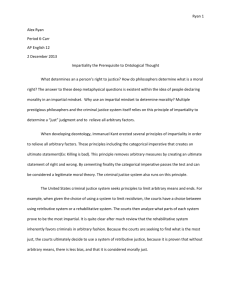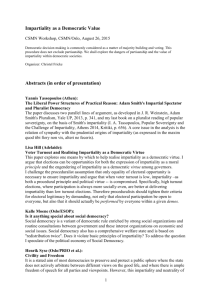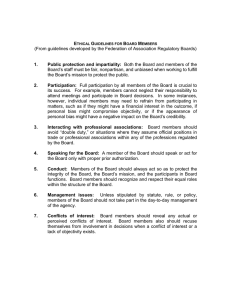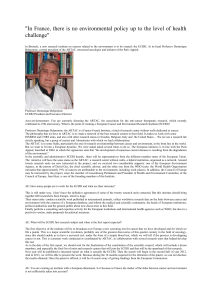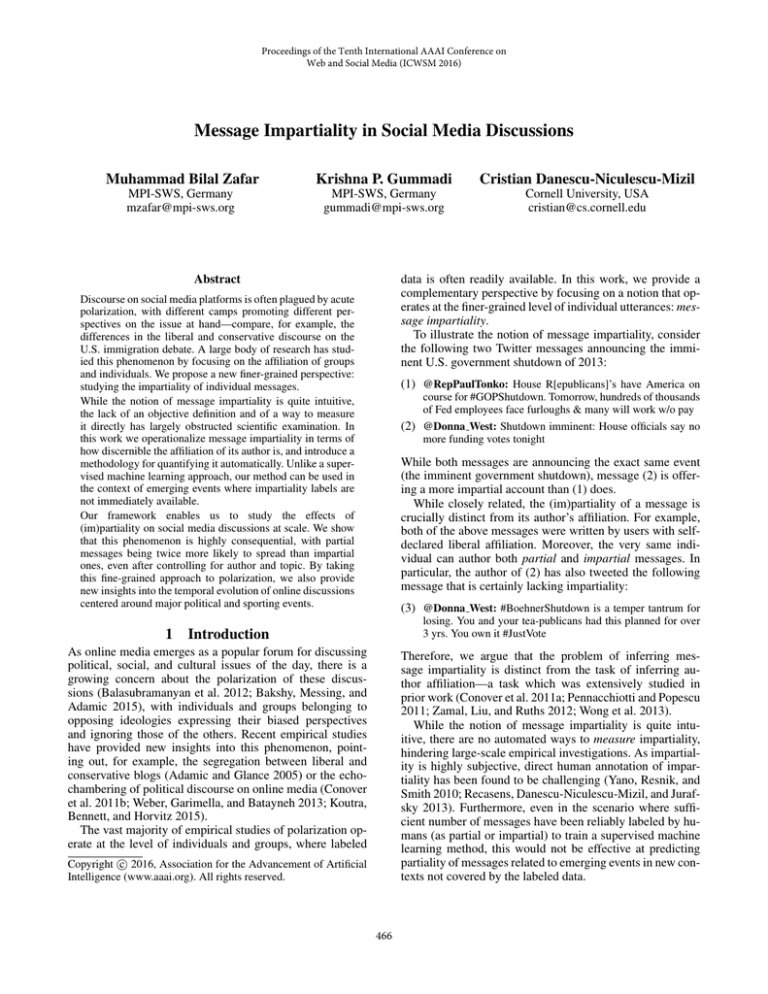
Proceedings of the Tenth International AAAI Conference on
Web and Social Media (ICWSM 2016)
Message Impartiality in Social Media Discussions
Muhammad Bilal Zafar
Krishna P. Gummadi
Cristian Danescu-Niculescu-Mizil
MPI-SWS, Germany
mzafar@mpi-sws.org
MPI-SWS, Germany
gummadi@mpi-sws.org
Cornell University, USA
cristian@cs.cornell.edu
data is often readily available. In this work, we provide a
complementary perspective by focusing on a notion that operates at the finer-grained level of individual utterances: message impartiality.
To illustrate the notion of message impartiality, consider
the following two Twitter messages announcing the imminent U.S. government shutdown of 2013:
Abstract
Discourse on social media platforms is often plagued by acute
polarization, with different camps promoting different perspectives on the issue at hand—compare, for example, the
differences in the liberal and conservative discourse on the
U.S. immigration debate. A large body of research has studied this phenomenon by focusing on the affiliation of groups
and individuals. We propose a new finer-grained perspective:
studying the impartiality of individual messages.
While the notion of message impartiality is quite intuitive,
the lack of an objective definition and of a way to measure
it directly has largely obstructed scientific examination. In
this work we operationalize message impartiality in terms of
how discernible the affiliation of its author is, and introduce a
methodology for quantifying it automatically. Unlike a supervised machine learning approach, our method can be used in
the context of emerging events where impartiality labels are
not immediately available.
Our framework enables us to study the effects of
(im)partiality on social media discussions at scale. We show
that this phenomenon is highly consequential, with partial
messages being twice more likely to spread than impartial
ones, even after controlling for author and topic. By taking
this fine-grained approach to polarization, we also provide
new insights into the temporal evolution of online discussions
centered around major political and sporting events.
1
(1) @RepPaulTonko: House R[epublicans]’s have America on
course for #GOPShutdown. Tomorrow, hundreds of thousands
of Fed employees face furloughs & many will work w/o pay
(2) @Donna West: Shutdown imminent: House officials say no
more funding votes tonight
While both messages are announcing the exact same event
(the imminent government shutdown), message (2) is offering a more impartial account than (1) does.
While closely related, the (im)partiality of a message is
crucially distinct from its author’s affiliation. For example,
both of the above messages were written by users with selfdeclared liberal affiliation. Moreover, the very same individual can author both partial and impartial messages. In
particular, the author of (2) has also tweeted the following
message that is certainly lacking impartiality:
(3) @Donna West: #BoehnerShutdown is a temper tantrum for
losing. You and your tea-publicans had this planned for over
3 yrs. You own it #JustVote
Introduction
As online media emerges as a popular forum for discussing
political, social, and cultural issues of the day, there is a
growing concern about the polarization of these discussions (Balasubramanyan et al. 2012; Bakshy, Messing, and
Adamic 2015), with individuals and groups belonging to
opposing ideologies expressing their biased perspectives
and ignoring those of the others. Recent empirical studies
have provided new insights into this phenomenon, pointing out, for example, the segregation between liberal and
conservative blogs (Adamic and Glance 2005) or the echochambering of political discourse on online media (Conover
et al. 2011b; Weber, Garimella, and Batayneh 2013; Koutra,
Bennett, and Horvitz 2015).
The vast majority of empirical studies of polarization operate at the level of individuals and groups, where labeled
Therefore, we argue that the problem of inferring message impartiality is distinct from the task of inferring author affiliation—a task which was extensively studied in
prior work (Conover et al. 2011a; Pennacchiotti and Popescu
2011; Zamal, Liu, and Ruths 2012; Wong et al. 2013).
While the notion of message impartiality is quite intuitive, there are no automated ways to measure impartiality,
hindering large-scale empirical investigations. As impartiality is highly subjective, direct human annotation of impartiality has been found to be challenging (Yano, Resnik, and
Smith 2010; Recasens, Danescu-Niculescu-Mizil, and Jurafsky 2013). Furthermore, even in the scenario where sufficient number of messages have been reliably labeled by humans (as partial or impartial) to train a supervised machine
learning method, this would not be effective at predicting
partiality of messages related to emerging events in new contexts not covered by the labeled data.
c 2016, Association for the Advancement of Artificial
Copyright Intelligence (www.aaai.org). All rights reserved.
466
Against this background, in this work, we propose and
validate an operational definition of message impartiality
that allows us to automatically quantify message impartiality
in a variety of contexts and emerging events, without needing to constantly regenerate impartiality labels. Our main insight is to exploit the inherent relation between impartiality
of a message and the discernibility of its author’s affiliation:
the more impartial a message, the harder it is to infer the
affiliation of its author from its content. For example, message (2) above is more impartial than (3) because it is harder
to predict the affiliation of its author (which is liberal) from
its content.
Building on this insight, we show how message impartiality can be successfully operationalized in terms of the confidence with which the its author’s affiliation can be inferred,
leading to a measure that aligns well with human intuition
across multiple events, spanning both politics and sports. We
further show that we can fully automate this framework, and
that, unlike a machine learning approach trained directly on
impartiality labels, our method can be used in the context
of emerging events where such labels are not immediately
available.
The ability to automatically quantify impartiality enables
a large scale exploration of online polarization from a new
fine-grained perspective, bringing new insights into this phenomenon. For example, we find that message impartiality is
highly consequential, with partial tweets being twice more
likely to be retweeted than impartial ones. This effect holds
even when the impartial and partial messages are on the
same topic and are sent by the same user.
One of the main motivations for focusing on messagelevel impartiality—rather than on author-level affiliation—is
the observation that single individuals can vary their level of
impartiality over time. To better understand this individuallevel variation we study the social media discourse related
to three major political and sporting events: the U.S. government shutdown of 2013, Super Bowl 2014 and Super Bowl
2015. We find that individual users do indeed change the
level of impartiality of their messages over the spread of an
event, and that, this variation is systematically tied to the
evolution of the offline event.
To summarize, in this paper we: propose new way to operationalize the concept of message impartiality (Section 2);
show that the resulting measure aligns with human judgments of impartiality (Section 3); develop a framework for
automatically quantifying message impartiality (Section 4);
conduct a large-scale study of message impartiality in the
Twitter social network (Section 5); and provide new insights
into this phenomenon (Section 6).
2
and discuss its relation to the better studied notion of affiliation. Building on this discussion, we then introduce a new
way to operationalize this phenomenon that will enable us
to quantify and study it at scale.
2.1
Characterizing the notion of impartiality
Consider the Twitter messages (1) and (2) shown in Section 1. Although both messages share the same news—
impending government shutdown—they differ dramatically
in the way they convey it. That is, message (1) is, at least
intuitively, less impartial than message (2). In this particular case, the difference seems to stem from the fact that
message (2) announces the imminent government shutdown
without leaning towards any party position, whereas, message (1) implicitly blames the Republicans while announcing the exact same news. While, this is an argument specific
to this example, it does highlight some of general properties
of the intuitive notion of impartiality:
1. Impartiality is a property of the message and not of its author. This follows the intuition that the knowledge of the
affiliation of a message’s author is not sufficient to determine whether the message is impartial or not. As exemplified in Section 1, authors from same affiliation can write
both impartial and partial messages (examples (2) and (3)
respectively) on the same topic.
2. Message impartiality is not an absolute notion and is defined with respect to a given context: a topic of discussion and a given set of (two or more) relevant affiliations
(liberal and conservative in our running example). Importantly, a message can be considered impartial in one
context and partial in another. For example, the message
“Broncos is the best team in the world” is blatantly partial in the context of the Super Bowl but impartial in the
context of the government shutdown.
3. Impartiality of a message is not related to the truth value
of the message. A true statement can be partial or impartial, depending on the context in which partiality is being determined. For example, the statement “Greenhouse
gases have risen”, while being true, might still convey liberal partiality in the context of the global warming debate. The reason is that this statement represents the liberal point of view on the topic and not the perspective
of conservatives, who generally deny the true statement
(McCright and Dunlap 2000).2
Finally, we note that while the concepts of impartiality
and sentiment seem related, high sentiment in a message
does not always imply high partiality and vice versa. We
discuss this further in Section 5.5.
2.2
Operationalizing impartiality
Operational definition of impartiality
To operationalize1 message impartiality, we need to understand what does it mean for a message to be impartial, and
how can we measure the impartiality of a message. Here we
propose an informal characterization of this intuitive notion
While the notion of impartiality described above is widely
and intuitively understood (Gert 1995), we still lack a direct way to measure the degree of impartiality of a given
message. We now propose an operational definition of this
concept that allows it to be objectively quantified:
1
Where, by operationalization, we mean making an intuitive
fuzzy concept measurable, as it is common in social sciences.
2
“Reality has a well known liberal bias.” — Stephen Colbert
(at the 2006 White House correspondents’ dinner).
467
Given a context (e.g., U.S. government shutdown) and a
set of two possible affiliations (e.g., liberal and conservative), the impartiality of a message refers to the uncertainty (or lack of confidence) in inferring the likely
affiliation of its author from the content of the message.
That is, the harder it is to infer the affiliation of a message’s author, the more impartial that message is.
real-world dataset. The dataset consists of tweet messages
related to the discussions of two highly polarized events:
1) U.S. government shutdown, posted by users with known
Democratic or Republican affiliation and 2) Super Bowl
2014, posted by known fans of Denver Broncos or Seattle
Seahawks (the two contestant teams). Details of how this
data was collected are given in Section 5.1.
For each of the two events, we select 400 messages (200
random messages from each affiliation) and for each message, we ask n = 10 different human judges to infer the
affiliation of the author of the message.
To get a set of reliable human judges, we use Amazon Mechanical Turk platform. We specifically use AMT ‘categorization masters’ who have a record of performing tasks with
high accuracy. Moreover, since we are focusing on events
pertaining to U.S. politics and sports, the workers were chosen to be exclusively from the U.S. Each AMT judge was
shown a set of 85 tweet messages related to one of the
events. For example, the question for annotating one message was:
Event: U.S. government shutdown of 2013
Tweet: We can’t stop the rain but together we can stop this
shutdown. Enough is enough. #JustVote to reopen the govt
Question: The user posting this tweet is:
Democratic-leaning
Republican-leaning
Judges were given 50 minutes to complete the task and
the reward for each task was set to 5 USD. To ensure quality
control, 5 out of 85 messages (placed at random points) in
each set were designated as ‘test messages’ and were chosen
such that their author affiliation was very clear. If a judge did
not infer correct author affiliation for at least 4 out of these
5 test messages, we discarded all of their responses.
Table 1 shows some of the messages where all the judges
inferred the same author affiliation (α = 10) and where only
around 50% judges (5 ≤ α ≤ 6) inferred the same affiliation: messages where affiliations were inferred with high
confidence do indeed seem partial, while ones where affiliations were inferred with low confidence appear to be impartial.
Applying this definition to our running examples, message (2) would be deemed impartial since the political affiliation of the author (liberal) cannot be inferred from the text.
On the other hand, the content of message (1) suggests that
the author was most probably a person with liberal affiliation
and hence it would be deemed partial.
Note that while this definition can can be intuitively extended to events with more than two affiliations, for the sake
of simplicity, in this work we only consider events with two
affiliations. Having more affiliations may give rise to complications (e.g., in a n-party system accommodating a scenario where multiple affiliations share the same perspective)
that would require a dedicated analysis. Hence, we leave it
as an avenue to be explored thoroughly in future work.
3 Validating the operational definition
of impartiality using human annotation
So far, our operationalization of message impartiality has
been agnostic regarding how the confidence in discerning
author affiliation of a message is estimated. In this section we will use human annotators to assess affiliationdiscernibility in order to establish the validity of our approach. In the next section, we will propose a method for
quantifying discernibility without relying on human labels,
therefore, fully automating our method for estimating message impartiality.
3.1
Determining affiliation-discernability using
human annotators
Task design (HAT-a). Assume a set of messages coming
from authors with two different affiliations A1 and A2 . The
goal is to evaluate how impartial each message is.
For each message we ask n different human judges to
guess the likely affiliation of the author of the message. We
estimate the confidence in discerning author affiliation as the
agreement level among the judges: the higher the agreement,
the easier it is to discern the affiliation of the author and thus,
the more partial the message. Formally, the agreement score
for the message can be computed as:
α = max(α1 , α2 ),
3.2
Alignment with human intuition
We now validate the methodology described above, by
checking whether the resulting message impartiality scores
align well with how humans intuitively perceive impartiality.
To this end, we collect direct impartiality judgments using
the following human annotation task.
Labeling message impartiality directly (HAT-direct).
For all the 400 messages for which we computed impartiality scores using the method described above, we also gather
“ground truth” (im)partiality ratings by asking 10 different
human annotators to directly judge whether the messages
are partial or impartial. Since we want these labels to reflect
the human judges’ intuitive perception of impartiality and
not any specific interpretation, we do not define impartiality or provide illustrative examples. Instead we simply ask
whether the messages are impartial or not with respect to
(1)
where αi is the number of humans that inferred the author
affiliation to be Ai . For highly partial messages, we expect
the human judges will have very high agreement (α close
to n), whereas for impartial messages, since the messages
themselves do not provide any cues about author affiliation,
the judges would be making random guesses, so the agreement should be close to n2 .
Task implementation. Having specified the design of the
task, we implement it to quantify message impartiality in a
468
Super Bowl
2014
Shutdown
2013
Event
Known author
affiliation
Democrat
Republican
Broncos
Seahawks
100% of judges agreeing on the author affiliation (α = 10)
Around 50% of judges agreeing on the author affiliation (5 ≤ α ≤ 6)
House Republicans just delivered Americans dysfunction, partisanship, and a #GOPshutdown. RT
to tell GOP to drop their extreme demands.
Its Day 4 of the Democrat’s shutdown & Republicans have been hard at work finding solutions.
Check out this timeline: [url]
Here we go! Let this be the ULTIMATE tale of 2
halfs! #GoBroncos #ComebackTime
We’ve waited 37 years to say this: Congratulations
on your Super Bowl XLVIII win @Seahawks!
#GoHawks #Champions #SeattlePride
O’Malley says Maryland will consider tapping reserve fund to deal with federal shutdown [url]
Tonight, our elected officials—or at least their
staffers—are holding some very caffeinated discussions. CNN 11pm #shutdown live now.
Been calling a Seattle vs Denver Super Bowl for
months btw.
Entering #SB48, the fewest points Broncos scored
w/ Peyton Manning was 17. Denver scored 8 on
Sunday.
Table 1: Example messages where all/half of the judges agreed on their inferred author affiliation.
the event and the respective sides.3 This way, each message
receives a ground truth partiality rating ranging from –10
to 10, corresponding to the difference between the number
of partial and impartial judgments it receives from different
annotators.4
To see if the impartiality scores α based on affiliationdiscernability (as obtained via HAT-a) align with the humans’ intuition of impartiality, we bin the messages into 6
different agreement bins corresponding to all possible α values, ranging from 5 through 10. Essentially, these bins correspond to the degree of agreement that the annotators had in
inferring the author affiliation in HAT-a: the agreement bin
of 10 contains all the messages for which annotators inferred
the same affiliation, while an agreement bin of 5 contains
messages for which half of the annotators inferred one affiliation and the other half inferred the other affiliation. Figure 1 shows the average ground truth partiality ratings for
each of these bins, as obtained via HAT-direct; for both
events the impartiality scores α align well with the ground
truth. 5 This validates our operational definition of impartiality, showing that the confidence with which the affiliation of
the author of a message can be discerned corresponds to the
intuitive perception of that message’s impartiality. Building
on this finding, in the next section we show how to automate
the task of estimating the discernibility of author affiliation.
4
Avg. partiality rating
6
6
4
4
2
2
0
-2
0
-4
-2
-6
5
6
7
8
9
Agreement bin (α)
10
(a) Govt. shutdown 2013
5
6
7
8
9
Agreement bin (α)
10
(b) Super Bowl 2014
Figure 1: Our estimation of affiliation-discernibility (obtained via HAT-a, x-axis) aligns well with humans’ intuitive
perception of message impartiality (ground truth partiality
ratings obtained via HAT-direct, y-axis).
2008; Borge-Holthoefer et al. 2015), and that these can exploited by machine learning classifiers to infer the author
affiliation automatically. While our goal is not to infer affiliation, our insight is that the posterior class probabilities
that these methods assign to each particular message can be
used to determine how easy it is to discern their author’s
affiliation. Following our operational definition, measuring
message impartiality is reduced to inferring class probabilities in author affiliation classification task. Next we explore
several supervised techniques for inducing class probabilities, which we train on a relatively small seed set of messages for which author affiliations are known. We note that,
crucially, as opposed to message impartiality labels, author
affiliation labels are often readily available in social media
systems and are generally persistent across events. This allows our paradigm to be applied in real-time to emerging
events without requiring any ad-hoc annotation.
Posterior class probabilities. We start by using two supervised classification algorithms trained to predict user affiliations: naive bayes and bootstrap aggregating with decision
trees, or bagged trees. Both of these estimate the posterior
class probabilities of the classified items; we will use the
maximum class probability for each message as its automatically inferred partiality score (henceforth referred to as mpscore). Naive bayes is a popular choice for text classification since it can efficiently handle items with sparse features.
Handling sparse features is specially important since tweet
messages are very short—maximum of 140 characters—and
Automating affiliation-discernibility
So far we have relied on human judgments to determine
whether the affiliation of the author of a message can be
easily inferred, and consequently, whether that message is
partial or not. However these methods are not scalable and
can not be applied to real-time emerging events for which
annotations are not available. We now show how to take
humans out of the loop by fully automating the affiliationdiscernability component of our paradigm.
Prior work has shown that messages contain cues about
the affiliation of their authors (Monroe, Colaresi, and Quinn
3
We also give the annotators the option to select “can’t tell” to
discourage random guesses; this was rarely selected (6% of labels).
4
Data available at impartiality.mpi-sws.org.
5
The Spearman rank correlation between the impartiality scores
α and the ground truth partiality ratings are 0.34 (p < 10−11 ) for
government shutdown and 0.45 (p < 10−20 ) for Super Bowl 2014.
469
Discussion
U.S. government shutdown
Sandy Hook school shooting
Zimmerman trial 2014
Immigration reform 2014
2015 SCOTUS ruling on SSM
Super Bowl 2014
Super Bowl 2015
a single message contains only a few features. On the other
side, bagged trees have been shown to produce more accurate posterior class probability estimates (Niculescu-Mizil
and Caruana 2005).
Unigram method. It is known that posterior class probability estimates provided by machine learning classifiers are often skewed and hard to interpret (Niculescu-Mizil and Caruana 2005). If available, weight vectors are not always representative of the relative importance on the features (King,
Tomz, and Wittenberg 2000). However, in many practical
applications, understanding why a message is labeled as being partial is desirable (Recasens, Danescu-Niculescu-Mizil,
and Jurafsky 2013).
Here we propose a simple unigram based method that
is specifically tailored to the task of inferring the discernibility of author affiliation. It is based on the observation
that some words can serve as cues of author affiliation, and
that the strength of their signal can be quantified (Monroe,
Colaresi, and Quinn 2008). Messages including cues with
strong affiliation-signals have easy to discern authorship,
and thus are partial. In its simplicity this method has the additional advantage of high interpretability, making the link
between content and (im)partiality transparent.
The unigram method for assigning mp-score to individual
messages consists of two main steps: 1) assigning a score to
all the unigrams used in all the messages in the discussion,
and 2) computing the mp-score of a message based on the
unigrams contained in it.
The process of assigning score to unigrams works as follows. Consider a discussion consisting of two different affiliations A1 and A2 ; as before, we assume to have a training corpus of messages posted by a seed set of authors with
known affiliations. For each unique unigram u in the corpus,
we compute the score of u towards an affiliation Ai as:
su,Ai = pu,Ai × log(
pu,Ai
),
qu,Ai
Table 2: Number of tweets for different discussions in our
dataset that are authored by users with known affiliations.
5
5.1
Dataset
Our dataset consists of Twitter discussions around five major events related to U.S. politics7 and two major sporting
events: Super Bowl 2014 and 2015 (Table 2).
For the politics-related events, we obtain a seed set of
users with known Democratic or Republican affiliations by
leveraging twitter lists (Ghosh et al. 2012). For the sports
events, we use keyword matching on the profile descriptions
of the users. For example, the two teams competing in Super Bowl 2014 were Denver Broncos and Seattle Seahawks,
so we take ‘broncos’ or ‘seahawks’ in the profile of a Twitter user to mean that this user is a supporter of (or affiliated
with) Denver Broncos or Seattle Seahawks respectively.
In order to collect messages related to a particular event,
we select tweets posted around the time when the event occurred by authors from both affiliations and filter them using
simple regular expressions. For example, we filtered tweets
related to Twitter discussion on President Obama’s executive action on immigration reform with the keyword pattern
(‘*immig*’) from the tweets posted between Oct. 26, 2014
to Dec. 05, 2014. 8
(2)
(3)
5.2
We can now assign a message partiality score mp-score
to any message related to the discussion, even if it is not
uttered by authors with known affiliations in our training
dataset. Consider message m that consists of z unigrams
(u1 , u2 , ..., uz ), and the corresponding scores of these unigrams are given as (su1 , su2 , ..., suz ), then the mp-score of
the message is:
mp-scorem = max(su1 , su2 , ..., suz ),
Evaluation
In this section, we evaluate the relative performance of our
automated methods in quantifying message impartiality, as
well as their effectiveness in retrieving impartial messages in
the scenario of an emerging event. To this end, we gathered a
dataset related to political and sports discussions on Twitter.
where pu,Ai is the fraction of authors with known affiliation
Ai using u and qu,Ai is the fraction of authors with a different known affiliation ({A1 , A2 } \ {Ai }) using u. 6
We compute the final score su of the unigram u as:
su = max(su,A1 , su,A2 ).
Num. of tweets
52,017
56,535
11,174
16,883
9,316
100,507
50,042
Implementation details
As features for the bagged tree classifier, we use all the
unigrams that appear more than 5 times in the messages related to the discussion. As an example, for the government
shutdown discussion we obtain a total of 7,994 features, and
for Super Bowl 2014 discussion we get 5,336 features. For
training the classifier, we use standard parameters (10 base
estimators, all samples and all features used for training each
base estimator, samples drawn with replacement). We train
(4)
where the max function here uses the unigram with the
highest score (or the most discerning unigram).
7
We selected these events by scanning the list of important
events in a year compiled by Wikipedia editors and extracting ones
with reasonably large participation from politics-related accounts.
8
The immigration reform was formally announced on Nov. 20,
2014, however, there was considerable debate on social media before and after the announcement.
6
Among multiple alternative methods for scoring unigrams, we
choose this one for its simplicity. For example, χ2 feature selection
leads to qualitatively similar results.
470
Government
shutdown
Super Bowl
2014
Dems/Broncos
#GOPShutdown
#DemandAVote
economy
hurting
#TimeToRide
#GoBroncos
orange
congratulate
Reps/Seahawks
#HarryReidsShutdown
#Obamashutdown
golf
priests
#GoHawks
#12s
champs
thanks
8
Avg. partiality rating
Discussion
8
Unigram method
Naive bayes
Bagged tree
6
4
4
2
2
0
0
0.2
0.4
0.6
0.8
mp-score bin
1
(a) Government shutdown
Table 3: Examples of highly partial unigrams related to political/sports discussions according to the unigram method.
0.2
0.4
0.6
0.8
mp-score bin
1
(b) Super Bowl 2014
Figure 2: The automatically inferred partiality scores (mpscore, x-axis) align well with human intuition (ground truth
partiality obtained via HAT-direct, y-axis). Bins with
less than 10 data-points are ignored.
the bagged tree classifier for each discussion, 9 and for each
message, we use the maximum predicted class probability
by the trained classifier as its mp-score.
Since naive bayes classifier can handle a large number
of features, we include bigram features as well. That is, for
training the naive bayes classifier, we use all the unigrams
and bigrams that appear more than 5 times in the training
set. We obtain a total of 15,640 features for naive bayes in
the case of government shutdown discussion and 9,558 features for Super Bowl 2014. Similar to the case of the bagged
trees, we train the naive bayes classifier 10 and use the maximum predicted class probability of the messages as their
mp-score.
In the unigram method we assign scores to all unigrams
in the corpus using Equation (3). Table 3 shows some unigrams with high scores, and offers some insights into the
partisanship of the discussions: the Democrats are blaming
the Republicans for hurting the economy, while Republicans
are blaiming Obama and are outraged that his favorite golf
courses were spared from the shutdown.
5.3
6
that are impartial and those that are mildly partial, which
can be attributed to the skewness in the estimation of posterior class probabilities (as previously discussed); in particular, the median class probability is 0.98 for naive bayes and
1.00 for bagged trees.
In the remainder of this paper we will use the unigram
method to study message impartiality at scale. Beyond providing a better alignment with human intuition, this method
also has the advantage of being transparent in terms of the
content features that contribute to the impartiality score.
5.4
Applicability to emerging events
One major advantage of our framework is that it can be
used to quantify impartiality of messages related to emerging events, as long as they involve the same pair of affiliations. In contrast, directly applying a supervised machine
learning method would involve regenerating partiality labels
for messages related to emerging events. Here we provide
empirical evidence for the advantage of our methodology
based on affiliation-discernability (henceforth discernability
method) by comparing it to a supervised machine learning
method trained directly on impartiality labels (henceforth direct ML method) to an event that was not previously used in
any of our analysis: the 2015 Supreme Court ruling on samesex marriage (henceforth SCOTUS ruling).
Since we treat the SCOTUS ruling as an emerging event,
neither of the methods has access to any new information or labels pertaining to this event. In this scenario, we
compare the performance of our affiliation-discernability
method with that of an SVM classifier directly trained
on human-annotated (im)partiality labels (gathered using
HAT-direct) for messages related to a prior event,
namely, the government shutdown.12
For evaluation, we collect ground truth partiality labels for
400 messages from the SCOTUS ruling (200 random messages from each affiliation) using HAT-direct and compare the two methods on the tasks of retrieving both partial and impartial messages. We rank the messages based
on class probability given by the SVM in the direct ML
Alignment with ground truth ratings
In order to measure the performance of our automated methods, we check the relation between the mp-score assigned by
these methods and the ground truth partiality ratings. We divide messages into five different bins based on the scores
assigned by each method: the first bin contains messages
deemed to be most impartial (the bottom 20th percentile of
all mp-scores), while the last bin contains messages considered most partial.
Figure 2 shows that the (im)partiality scores inferred by
our automatic methods align well with human perception
for messages related to both the Shutdown and Super Bowl
events. 11 Note that our affiliation-discernability methods do
not rely on any human-generated impartiality labels. We also
find that the implementations based on machine learning
classifiers do not distinguish very well between messages
9
The 10-fold cross validation accuracy was 80.3% for shutdown discussion and 86.7% for Super Bowl 2014.
10
The 10-fold cross validation accuracy was 87.1% for shutdown discussion and 88.5% for Super Bowl 2014.
11
The Spearman rank correlation between the mp-score assigned
by these implementations and the ground truth partiality are 0.41,
0.25 and 0.20 for unigram method, naive bayes and bagged trees,
respectively, for government shutdown (p-values < 10−6 ); for Superbowl 2014, these are 0.45, 0.33 and 0.36 (p-values < 10−11 ).
12
The cross-validation accuracy of the SVM on the government
shutdown event is 77%.
471
Method
Direct ML method
Discernability method
Partial
0.95
1.00
Impartial
0.10
0.60
Discussion
Government shutdown
Super Bowl 2014
Table 4: Precision@20 for the task of retrieving partial and impartial messages in an emerging event. Our
affiliation-discernability method outperforms a machine
learning method that is trained directly on impartiality labels.
Table 5: The average ground truth partiality ratings for messages that fall in our binary (im)partiality bins.
author affiliations to quantify impartiality. Even so, annotating author affiliations for each event is still more efficient
than annotating individual messages, since often in social
media, the number of users is significantly less than the number of messages that they are producing.
Finally, we explore the extent to which the (im)partiality
of a message is related to the sentiment it expresses. We take
100 most partial and 100 most impartial tweets—as identified by the unigram method—posted by both Democratic
and Republican leaning users from the discussion related to
the U.S. government shutdown 2013. We labeled the sentiment of each tweet using a state-of-the-art Twitter sentiment
classifier (Gonalves et al. 2013). We find that the average
sentiment score for partial and impartial tweets posted by
Democrats is −0.22 and −0.25 respectively, whereas, the
respective average sentiment score for partial and impartial
tweets from Republicans is −0.28 and −0.20. The negative
sentiment was expected, as the shutdown was generally perceived as a negative event. Similar sentiment score for both
partial and impartial tweets (from both Democratic and Republican sides) suggests that, at least in this case, the degree
of impartiality of a message is not tightly related to the sentiment contained within.
13
and, respectively, the mp-score of the discernmethod
ability method. For both methods, we compute the precision@20, a standard information retrieval metric used for
evaluating retrieval tasks.14
The results are shown in Table 4: both methods have high
precision@20 for retrieving partial messages. However, for
the task of retrieving impartial messages, the discernability
method has a much higher precision@20 than the direct ML
method. This confirms our intuition that while affiliationdiscernability transfers well from one event to another, this
is not the case for direct supervised methods of measuring
impartiality, as they rely on event-specific cues and thus require new impartiality-annotated data for each new event.
5.5
Avg. partiality rating
Impartial
Partial
−1.2
4.7
−0.6
5.8
Limitations and discussion
Our evaluation of the three implementations of our automated methodology shows that they can measure impartiality reasonably well on real-world datasets related to political and sporting events. As a first attempt to quantify this
phenomenon, this framework has some important limitations. For example, it can fail in particular cases involving
the use of creative language, such as sarcasm, and there is
room for introducing better linguistically informed methods
for quantifying impartiality. For example, one could devise
methods that leverage negations, hedges, discourse markers
and conversational patterns to infer author affiliation more
robustly. Similarly developing better machine learning techniques that provide more realistic class probability estimates
could also lead to better performance. Since such improvements fall beyond the scope of this paper, we leave it as a
venue to be explored in future work.
We showed that an advantage of our methodology stems
from the fact that affiliation labels are more persistent across
events, as opposed to message-level impartiality annotations. For example, there are many events related to U.S. politics (U.S. government shutdown 2013, Sandy Hook shootings, George Zimmerman’s trial, etc.) for which one could
use same seed set of users with known Democratic and Republican affiliations to quantify impartiality in messages related to any of these discussions. However, there might be
cases where individual users change affiliations, either following a major event (2015 attacks on Charlie Hebdo offices) or gradually over time (acceptance of gay marriage in
a community). In these cases, one would need to re-annotate
6 Case study:
Impartiality in Twitter discussions
We now apply the methodology developed so far to characterize impartiality in Twitter discussions at scale. Specifically, we ask the following questions about the dynamics of
impartiality:
• Does partial content spread more virally than impartial
content?
• Does the level of message (im)partiality change during the
course of a discussion?
• Do individual users change their levels of (im)partiality
during the course of a discussion?
Does partial content spread more virally than impartial
content? We compare the virality of partial and impartial
messages in our dataset, where virality of a message is taken
to be the number of times it was retweeted. 15
So far, we have used a continuous measure of message impartiality. For the purpose of this analysis we assign binary
partial/impartial labels to messages based on the distribution
of the mp-score in the labeled part of the data. We mark all
13
Using bagged tree and naive bayes instead of SVM in direct
method also produces very similar results.
14
We consider messages with a ground truth partiality rating
greater than 2 (smaller than −2) as being partial (impartial).
15
For the tweets considered here, we re-gathered their retweet
counts from Twitter API at least one month after the discussion to
make sure that the retweet counts have stabilized.
472
Discussion
Government shutdown
Sandy Hook Shooting
Zimmerman Trial
Super Bowl 2014
# Users
231
120
67
339
Avg. of PAR
0.162(22.3)
0.182(20.5)
0.143(30.4)
0.010(5.9)
Avg. of IMP
−0.331(14.4)
−0.191(12.1)
−0.149(15.1)
−0.141(2.2)
p-value
< 10−14
< 10−6
< 0.01
< 0.05
Table 6: Partial messages are twice more likely to be retweeted: p-values for Wilcoxon signed-rank test for the comparison
of partial (PAR) and impartial (IMP) tweets. For all the events, the normalized virality (z-score) is above the per-user average
for partial messages (> 0) and below per-user average for impartial messages (< 0). The un-normalized virality (shown in
parentheses) for partial messages is roughly double that of impartial messages.
messages with mp-score < 0.1 as impartial and all those
with mp-score ≥ 0.4 as partial. As shown in Table 5, this
binary binning aligns well with human intuition.
To analyze the impact of impartiality on message virality,
we need to disentangle it from the popularity of the topic
in which a message appears and from characteristics of its
author. For example, highly popular users (having millions
of followers) are likely to be retweeted more than less popular users, regardless of what they tweet. Similarly, a highly
popular discussion will inherently attract more retweets.
To control for these confounding factors, we compare the
virality of partial and impartial messages posted by the same
user within a given discussion. To this end, we standardize
the retweet counts of all the messages of a user by converting
individual retweet counts to their z-score,16 after discarding
users that did not post at least one partial and one impartial
message during the discussion. This leads to a within-user
paired comparison to which each user contributes equally:
for each user we take the average virality z-score of their
partial messages (PAR), and the average virality z-score of
their impartial messages (IMP), and compare the resulting
two sets using Wilcoxon signed-rank test. The results of this
paired statistical test (Table 6) show that partial messages
are indeed significantly more likely to be retweeted than impartial ones, even when they are sent by the same author and
are on the same topic.
Avg. partiality
0.5
0.4
0.3
0.2
Sep-22
Oct-02
Oct-12
Oct-22
Figure 3: Fluctuations in partiality (mp-score) over the development of the Shutdown 2013 event; solid line indicates
October 1st, the day the government shut down.
Do individual users change their levels of (im)partiality
during the course of a discussion? As exemplified in the
introduction, an author with a given affiliation can post both
partial and impartial messages. Here, we study this phenomenon more generally and investigate whether individual
users in Twitter vary their levels of (im)partiality over time.
In order to study the change in individual users’
(im)partiality over time, we consider three discussions: U.S.
government shutdown of 2013, Super Bowl 2014 and Super
Bowl 2015. We divide these discussions into three different time intervals: before the event, during the event and after the event. For users with known affiliations (Democrats /
Republicans, Broncos / Seahawks, Patriots / Seahawks) who
have posted messages in all three intervals, we calculate
their average partiality (the average mp-score of the messages that they posted) during each interval.
Figure 4 shows the changes in average user partiality during the three events. It can be seen that in all three discussions, the average partiality is high around the time when the
event was taking place. This confirms our intuition that even
users with set affiliations can vary their level of partiality
during the course of a discussion.
Does the level of message (im)partiality change during
the course of a discussion? To answer this question, we
analyze the average daily message partiality in the discussion of U.S. government shutdown of 2013—an event that
went through several offline developments. The results, presented in Figure 3, show that the discussion stays somewhat impartial untill Sep. 26, 2014. However, we see a sharp
rise in partiality on Sep. 27, corresponding to the U.S. Senate amending a bill related to Affordable Care Act, a move
which would eventually lead to the Oct. 1 shutdown. Similarly, we see an increase in partiality immediately after the
start of shutdown. Further fluctuations in partiality can also
be mapped to offline developments. Finally, after the shutdown ended on Oct. 16, we can see gradual decrease in partiality suggesting that the discussions returns to a relatively
impartial point after the issue has been resolved.
7
Related work
A large body of research has focused on detecting polarization in various offline and online contexts. For example,
studies have analyzed congressional votes in order to understand polarization in the context of U.S politics (McCarty, Poole, and Rosenthal 2006, inter alia). Similarly,
other studies have shown that political discussions in online world occur within highly polarized communities of
users sharing similar political leanings or ideologies, with
relatively little exchange of information between commu-
16
Z-score of a sample indicates the signed number of standard
deviations that the sample is away from the population mean. Converting a retweet count to z-score ensures that popular users with
high retweet counts do not skew the analysis.
473
Avg. partiality per user
data, such as the Wikipdia NPOV corpus. In this work, we
devise a framework that is applicable in settings where impartiality labels are not available, such as emerging events,
enabling a large scale investigation of the phenomenon.
0.6
0.4
0.3
0.4
0.2
0.2
0.2
0.1
0.0
Sep-20 to
Oct-01 to
Oct-20 to
Sep-28
Oct-17
Oct-30
(a) Shutdown 2013
0.0
Jan-20 to
Feb-01 to
Feb-08 to
Jan-26
Feb-04
Feb-14
0.0
Jan-22 to
Jan-31 to
Feb-07 to
Jan-27
Feb-03
Feb-11
8
(b) Super Bowl 2014 (c) Super Bowl 2015
Conclusion and future work
In this paper, we made the case for a finer-grained approach
to polarization in social media by analyzing the impartiality
of individual messages. While the notion of message impartiality is intuitive, a lack of automated ways to measure it has
hindered scientific inquiry so far. Against this background,
we proposed an operationalization of the intuitive notion of
message impartiality based on affiliation-discernability. We
validated that the resulting measure aligns with human judgments of impartiality and then proposed ways in which the
methodology can be automated. Since this method relies on
a seed set of known author affiliations, which are generally
more persistent and more easily obtainable than direct message partiality labels, our framework can be applied in real
time to emerging events without requiring new annotations.
Having an automated measure for judging message impartiality enabled us to conduct a large-scale study of message
impartiality in Twitter discussions. This provided new insights not only into how impartiality of a message impacts
its chances of spreading, but also on how impartiality of social media discussions (and of single users) varies over time.
Our work also opens numerous opportunities for future
studies. First, having a reliable distinction between partial
and impartial messages can be used to inform social media
users about the degree of impartiality of the content they are
consuming. This distinction could be leveraged for the task
of balanced news reporting.
The performance of our automated method could be improved further by better integrating linguistic information
and by using machine learning approaches that are better
suited for measuring affiliation-discernability. To make our
approach more general, we envision unsupervised methods
that can jointly learn to detect message impartiality and author affiliations. To this end, we are distributing the annotated data to encourage future work on this phenomenon.17
In future work we plan to explore the nature of the interplay between impartiality and related concepts like disagreement (Allen, Carenini, and Ng 2014; Wang and Cardie
2014), credibility (Gupta et al. 2014) and rationality (Liu
and Weber 2014). Understanding the role that impartiality
plays in the outcome of consequential interactions, such as
teamork (Niculae et al. 2015a) and debates (Romero et al.
2015; Tan et al. 2016; Zhang et al. 2016) is also an interesting avenue for future work.
Figure 4: Change in user partiality (mp-score) around major
events; each bin reflects the partiality of messages posted by
the same group of users during the three intervals. Consistently across the three events, users post more partial messages around the time the event takes place (middle bars).
nities (Adamic and Glance 2005; Conover et al. 2011b;
Weber, Garimella, and Batayneh 2013). Some prior studies
have explored the bias of media sources using human annotations (Yano, Resnik, and Smith 2010; Budak, Goel, and
Rao 2015) or unsupervised methods (Niculae et al. 2015b).
In this work, we provide a finer-grained perspective on polarization by designing a framework that operates at the
granularity of individual messages.
Another line of research has focused on detecting the political leaning of individual users in social media (Conover
et al. 2011a; Pennacchiotti and Popescu 2011; Zamal, Liu,
and Ruths 2012; Wong et al. 2013). As discussed in the introduction, the problem of measuring the impartiality of an
individual message is crucially different from that of detecting its author affiliation.
A number of studies have used difference in language
usage to detect polarity. For example, our unigram implementation is directly inspired by a comparison of methods
capturing partisanship-inducing words in senate speeches
(Monroe, Colaresi, and Quinn 2008). Another study pointed
out that difference in usage of a hashtag by two parties can
be used to measure political leaning (Weber, Garimella, and
Teka 2013). In the context of Egyptian politics language differences are used to classify tweets into pro and anti-military
categories (Borge-Holthoefer et al. 2015). We use insights
from these studies to propose an automated way to quantify
message impartiality.
The problem of detecting impartiality in a message is
also different from detecting sentiment (Pang, Lee, and
Vaithyanathan 2002) and subjectivity (Wiebe et al. 2004).
While earlier works have tried to use sentiment analysis to
quantify political polarity of messages (Wong et al. 2013, inter alia), and showed that news articles with high sentiment
tend to attract more popularity (Reis et al. 2015), we show
that the sentiment of a message does not necessarily correspond to its partiality. Similarly, the lack of any subjectivity cues in our introductory example (1) illustrates how the
problem of quantifying impartiality is distinct from detecting subjectivity, a point that is addressed in more detail in
(Recasens, Danescu-Niculescu-Mizil, and Jurafsky 2013).
Finally, earlier studies focusing on impartial language
(Yano, Resnik, and Smith 2010; Recasens, DanescuNiculescu-Mizil, and Jurafsky 2013) have relied on labeled
Acknowledgments We thank the anonymous reviewers
for their helpful suggestions and Evgeniy Gabrilovich, Ravi
Kumar, Alexandru Niculescu-Mizil, Noah Smith and Arthur
Spirling for their insightful comments. This work was supported in part by a Google Faculty Research Award.
17
474
Available at impartiality.mpi-sws.org.
References
identifying the content of political conflict. Political Analysis.
Niculae, V.; Kumar, S.; Boyd-Graber, J.; and DanescuNiculescu-Mizil, C. 2015a. Linguistic harbingers of betrayal: A case study on an online strategy game. In Proc.
ACL.
Niculae, V.; Suen, C.; Zhang, J.; Danescu-Niculescu-Mizil,
C.; and Leskovec, J. 2015b. Quotus: The structure of political media coverage as revealed by quoting patterns. In Proc.
WWW.
Niculescu-Mizil, A., and Caruana, R. 2005. Predicting good
probabilities with supervised learning. In Proc. ICML.
Pang, B.; Lee, L.; and Vaithyanathan, S. 2002. Thumbs up?
Sentiment classification using machine learning techniques.
In Proc. EMNLP.
Pennacchiotti, M., and Popescu, A.-M. 2011. A machine
learning approach to Twitter user classification. In Proc.
ICWSM.
Recasens, M.; Danescu-Niculescu-Mizil, C.; and Jurafsky,
D. 2013. Linguistic models for analyzing and detecting
biased language. In Proc. ACL.
Reis, J.; Benevenuto, F.; Olmo, P.; Prates, R.; Kwak, H.; and
An, J. 2015. Breaking the news: First impressions matter on
online news. In Proc. ICWSM.
Romero, D. M.; Swaab, R. I.; Uzzi, B.; and Galinsky, A. D.
2015. Mimicry is presidential. Personality and Social Psychology Bulletin.
Tan, C.; Niculae, V.; Danescu-Niculescu-Mizil, C.; and Lee,
L. 2016. Winning arguments: Interaction dynamics and persuasion strategies in good-faith online discussions. In Proc.
WWW.
Wang, L., and Cardie, C. 2014. A piece of my mind: A
sentiment analysis approach for online dispute detection. In
Proc. ACL.
Weber, I.; Garimella, V. R. K.; and Batayneh, A. 2013. Secular vs. Islamist polarization in Egypt on Twitter. In Proc.
ASONAM.
Weber, I.; Garimella, V. R. K.; and Teka, A. 2013. Political
hashtag trends. In Proc. ECIR.
Wiebe, J.; Wilson, T.; Bruce, R.; Bell, M.; and Martin, M.
2004. Learning subjective language. Computational Linguistics.
Wong, F. M. F.; Tan, C. W.; Sen, S.; and Chiang, M. 2013.
Quantifying political leaning from Tweets and Retweets. In
Proc. ICWSM.
Yano, T.; Resnik, P.; and Smith, N. A. 2010. Shedding
(a thousand points of) light on biased language. In Proc.
NAACL HLT.
Zamal, F. A.; Liu, W.; and Ruths, D. 2012. Homophily
and latent attribute inference: Inferring latent attributes of
Twitter users from neighbors. In Proc. ICWSM.
Zhang, J.; Kumar, R.; Ravi, S.; and Danescu-NiculescuMizil, C. 2016. Conversational Flow in Oxford-style Debates. In Proc. NAACL.
Adamic, L., and Glance, N. 2005. The political blogosphere and the 2004 US election: Divided they blog. In Proc.
LinkKDD.
Allen, K.; Carenini, G.; and Ng, R. T. 2014. Detecting disagreement in conversations using pseudo-monologic rhetorical structure. In Proc. EMNLP.
Bakshy, E.; Messing, S.; and Adamic, L. 2015. Exposure
to ideologically diverse news and opinion on Facebook. Science.
Balasubramanyan, R.; Cohen, W. W.; Pierce, D.; and Redlawsk, D. P. 2012. Modeling polarizing topics: When do different political communities respond differently to the same
news? In Proc. ICWSM.
Borge-Holthoefer, J.; Magdy, W.; Darwish, K.; and Weber,
I. 2015. Content and network dynamics behind Egyptian
political polarization on Twitter. In Proc. CSCW.
Budak, C.; Goel, S.; and Rao, J. M. 2015. Fair and balanced?
Quantifying media bias through crowdsourced content analysis. In Proc. ICWSM.
Conover, M. D.; Goncalves, B.; Ratkiewicz, J.; Flammini,
A.; and Menczer, F. 2011a. Predicting the political alignment of Twitter users. IEEE Xplore.
Conover, M. D.; Ratkiewicz, J.; Francisco, M.; Goncalves,
B.; Flammini, A.; and Menczer, F. 2011b. Political polarization on Twitter. In Proc. ICWSM.
Gert, B. 1995. Moral impartiality. Midwest studies in Philosophy.
Ghosh, S.; Sharma, N.; Benevenuto, F.; Ganguly, N.; and
Gummadi, K. 2012. Cognos: Crowdsourcing search for
topic experts in microblogs. In Proc. SIGIR.
Gonalves, P.; Arajo, M.; Benevenuto, F.; and Cha, M. 2013.
Comparing and combining sentiment analysis methods. In
Proc. COSN.
Gupta, A.; Kumaraguru, P.; Castillo, C.; and Meier, P. 2014.
TweetCred: A real-time web-based system for assessing
credibility of content on Twitter. In Proc. SocInfo.
King, G.; Tomz, M.; and Wittenberg, J. 2000. Making
the most of statistical analyses: Improving interpretation and
presentation. American Journal of Political Science.
Koutra, D.; Bennett, P.; and Horvitz, E. 2015. Events and
controversies: Influences of a shocking news event on information seeking. In Proc. WWW.
Liu, Z., and Weber, I. 2014. Is Twitter a public sphere for
online conflicts? A cross-ideological and cross-hierarchical
look. In Proc. SocInfo.
McCarty, N. M.; Poole, K. T.; and Rosenthal, H. 2006. Polarized America: The dance of ideology and unequal riches.
MIT Press Cambridge.
McCright, A. M., and Dunlap, R. E. 2000. Challenging
global warming as a social problem: An analysis of the conservative movement’s counter-claims. Social Problems.
Monroe, B. L.; Colaresi, M. P.; and Quinn, K. M. 2008.
Fightin’ words: Lexical feature selection and evaluation for
475

